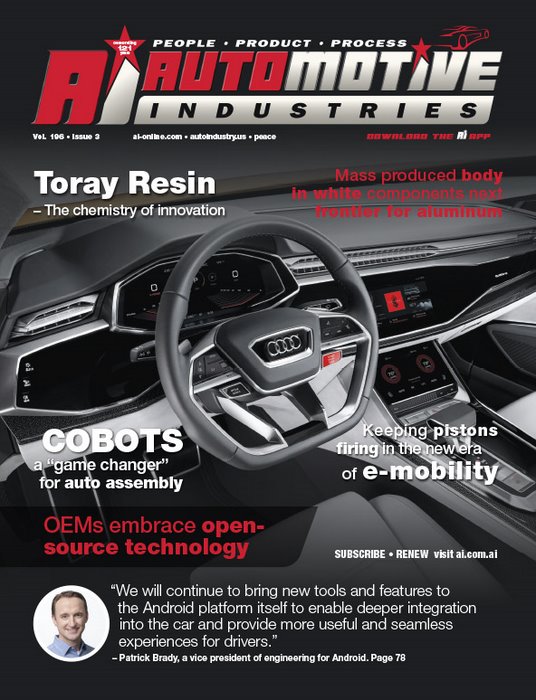
Google’s Android system has evolved since the 2014 launch of the stand-alone Android Auto app to a full in-vehicle operating system.
Volvo and Audi announced that they would be building Android into their next generation of cars in the run-up to the May Google Developer Conference Google I/O 2017. The first version of Android Auto connected Android-powered smartphones to car screens. It now runs on 300 car models, and is also available as a standalone phone application. Google has demonstrated the built-in version on the Audi Q8 and Volvo V90 SUVs. The new system plunges deeper, taking over the underlying software on the car. A driver doesn’t need to plug in an Android phone to run it. It also adds some features, like 3-D mapping and satellite images that are not available in Android Auto.
Patrick Brady, a vice president of engineering for Android, says the system will make its way to Audi and Volvo’s entire fleets, along with those of other manufacturers. Google showed a concept of the software running on a Chrysler vehicle earlier this year. Brady said this fusion of apps and controls into a single car display is the way the market is heading.
According to Kirsten Korosec of The Verge online publication, the retrofitting of Android into a Maserati Ghibli, which was demonstrated at last year’s Google developer conference, marked a turning point for automotive manufacturers which had traditionally spent years trying to develop their own proprietary software. “Automakers, from Hyundai to Jeep, are already adopting Google’s Android Auto product, an in-car platform released in 2015 that brings the functions and look of a smartphone to the vehicle’s central screen. Its closest competitor, Apple CarPlay, introduced a similar product to production cars that same year. Android Auto is in cars, but it’s not an operating system. It’s the HMI layer — or a secondary interface — that sits on top of the operating system. Android is an open-source mobile operating system that runs on Linux and is designed for smartphones and tablets,” says Korosec in a May 2017 article in Verge.
Android Auto supports several functions such as GPS mapping, navigation, music control, telephony, SMS composition and playback and web search. An Android Auto software development kit allows developers to modify their apps to work with Android Auto. According to Google, Apple’s CarPlay, which is a similar product to Android Auto, can run on top of cars with the embedded Android system.
Korosec points out that Google added new features to Android in 2016 so automakers could use it to run the infotainment system in cars, as well as functions like heating and cooling, opening and closing the windows, and even the speedometer and fuel gauge on the instrument cluster.
Writes Korosec: “Audi and Volvo are the first automakers to publicly express interest in bringing the Android operating system into their cars. The two automakers announced partnerships with Google ahead of I/O developer’s conference that kicks off today. Google will have demonstrations of running on an Audi Q8 and a Volvo V90 sport utility vehicle. Volvo says it expects to start shipping new cars with an Android operating system in about two years, a spokesman said. Audi is taking a more cautious approach. The company says it hasn’t decided whether to bring Android in production cars, but is working on concepts, a spokeswoman said. Audi says using Android would allow it to speed up development of its infotainment systems and tap into the millions of Android developers who create and program new apps and functions.”
Automotive Industries (AI) asked Patrick Brady VP Android Auto, to describe Google’s journey with the automotive industry.
Brady: Google has been working closely with the auto industry for over a decade, from bringing Google Earth into car systems to providing manufacturers with access to Google’s tools and services so that they could develop a variety of applications. While these partnerships had been successful, we found over time that porting applications to each manufacturer’s proprietary platform did not allow the speed of update and innovation to happen as fast as we had hoped.
AI: How did Android Auto develop from this?
Brady: Together with the industry we founded The Open Automotive Alliance (OAA) in 2014. OAA is a group of automakers and technology companies that came together to bring the best of Android into the infotainment systems in a safe and seamless way. Also in 2014, we launched Android Auto, which represented the first step in working with automakers to take a platform-centric approach to application development.
The latest effort we are making in this space is to enable automakers to quickly and efficiently integrate the Android platform itself as an embedded in-car operating system for their vehicle infotainment. We previewed a concept vehicle based on Android for the first time in May 2016, and have since been working with a number industry partners to bring Android into production cars.
AI: How will Alphabet Inc’s Waymo impact the reach of Android Auto?
Brady: We believe that just like any car, self-driving vehicles will need an infotainment system upon becoming mainstream in the future. Our team talks with Waymo regularly, as we do with other partners in the industry, to have discussions about enabling seamless connected experiences.
AI: What were some of the major developments as far as Android Auto is concerned at the I/O developer conference in May?
Brady: With regards to Android Auto, we announced that there are now more than 300 compatible cars and aftermarket stereos. We also showed the latest progress toward supporting Waze and wireless connectivity on Android Auto. As for Android as an in-car platform, we partnered with Audi and Volvo to demonstrate the integration in production cars for the first time. Both brands offered a demo vehicle for the Google I/O conference, allowing over 7,000 attendees to witness the integration in action.
AI: How has Android Auto built up its relationships with OEMs and how much of an impact has it had?
Brady: Car makers are taking on new technologies at an incredible speed, as they respond to an ever-increasing customer demand to have access to services and applications in the car in a much safer way. It is very clear that Google and car makers share a common vision, which is to leverage the open ecosystem around a common platform to drive innovation in the car and bring cutting-edge technology more quickly to drivers.
AI: What contributed to Android being first off the block in getting OEMs to build in the infotainment platform as opposed to using their own platforms?
Brady: Android is the world’s most popular mobile platform with more than two billion active devices worldwide. It is an open-source platform that provides great flexibility and customizability for car makers to build a powerful infotainment experience from ground up, all for free. Car makers are also able to take part in a vibrant ecosystem of manufacturers, silicon vendors and application developers with an existing user base.
AI: What do you see as the future of Android in the automotive space over the next couple of years?
Brady: We will continue to bring new tools and features to the Android platform itself to enable deeper integration into the car and provide more useful and seamless experiences for drivers. For Android Auto our goal is to keep working closely with the industry to grow the number of compatible cars and aftermarket stereos, while continuing to add new features based on user feedback and trends.









More Stories
Cybord warns of dangers of the stability illusion
How Modern Power Management Enhances Connected Fleet Tech
Avery Dennison PSA tapes support rapid evolution of EV batteries